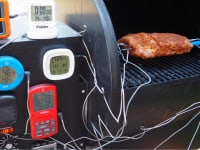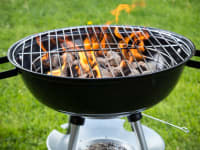Weber has its own probe thermometer for grilling—here's how it works
We tested the Weber Connect against other top-rated probe thermometers.
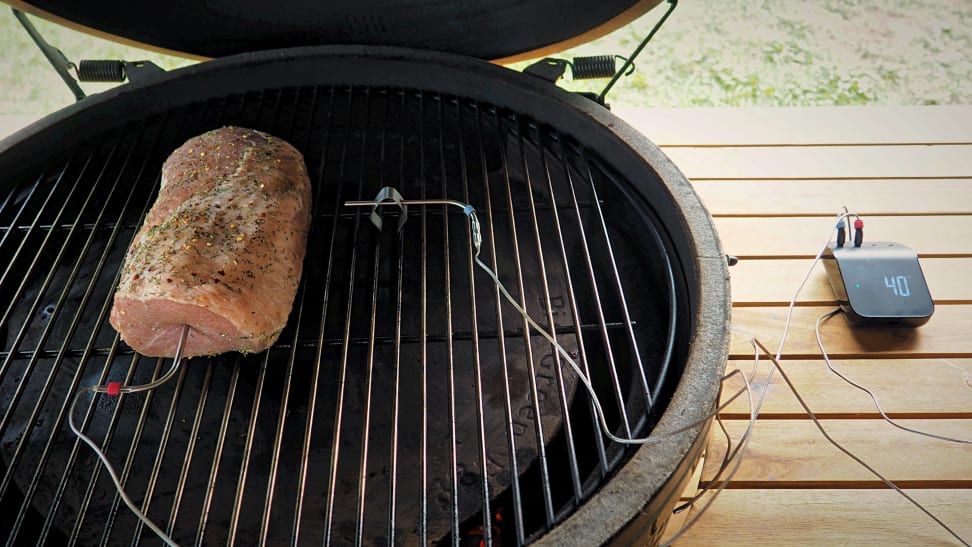 Credit:
Reviewed/Lindsay D. Mattison
Credit:
Reviewed/Lindsay D. Mattison
Recommendations are independently chosen by Reviewed's editors. Purchases made through the links below may earn us and our publishing partners a commission. Prices were accurate at the time this article was published but may change over time.
For many, grilling can be a stressful experience. It doesn’t matter whether you’ve mastered the art of lighting briquettes for a charcoal grill or you’re using easy-to-ignite gas and electric grills: You still have to deal with a backyard full of onlookers while you work. Expectations run high, and the pressure of not over- or undercooking meat can be too much to handle. No one wants to ruin an expensive steak in the process!
That’s where a probe thermometer can really save the day. Simply probe the meat, fire up the grill, and monitor the internal temperature without having to open the lid and let the heat out. Of course, you still have to know when to flip your steaks so they cook evenly on both sides, or the best time to wrap a smoked pork shoulder or brisket to keep it from drying out.
Luckily, one of the most well-known names in grilling has created a gadget to help with those types of issues. The idea behind the $129 Weber Connect probe thermometer (currently on sale for $99) is to deliver the right information at the right time, providing grillers with the key to developing their skills and getting perfect results every time. The best part: You don’t need to own a Weber grill to make it work.
What makes the Weber Connect different from other probe thermometers?
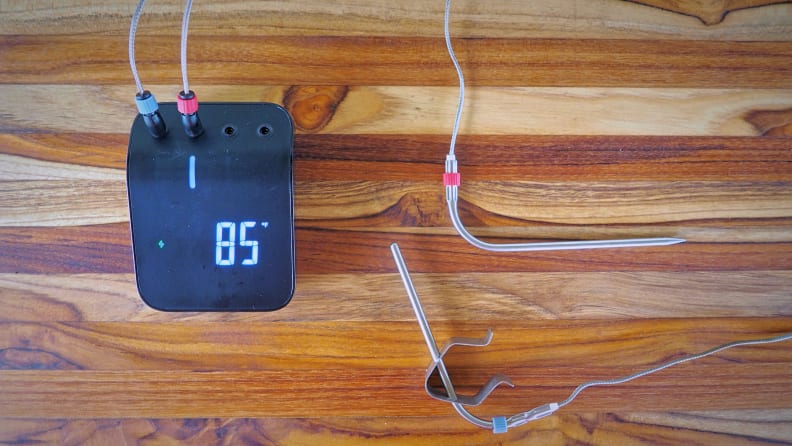
The Weber Connect comes with two probes: one to measure the meat's internal temperature and a shorter probe for the grill's ambient temperature.
Unlike instant-read thermometers, probe thermometers are designed to monitor real-time internal temperatures. They’re inserted into the thickest part of the meat while it’s still raw, allowing you to pinpoint the exact moment your food reaches its ideal temperature. Some models are wireless while others—like the Weber Connect—use durable, stainless-steel wires designed to withstand a grill or oven’s high temperatures.
The Weber Connect is somewhat unique because of its smartphone capabilities. Most probe thermometers require your presence to view the probe’s temperature. Some have remote wireless receivers, but you have to remember to bring them with you, and the receiver may drop the connection when it’s not in sight of the probe’s base. Instead, the Weber connects to your smartphone via WiFi or Bluetooth. It’s compatible with iPhones on iOS 12.1 or later and most smartphones on Android 7.0 or later.
The app not only monitors the internal temperature of meat and the ambient temperature of the grill, but it also provides step-by-step assistance and notifications. After you set up your cooking program, you’ll receive a cook-time countdown, notifications when it’s time to flip the food or change the grill’s temperature, and an alert when the meat reaches its target temperature.
How we tested
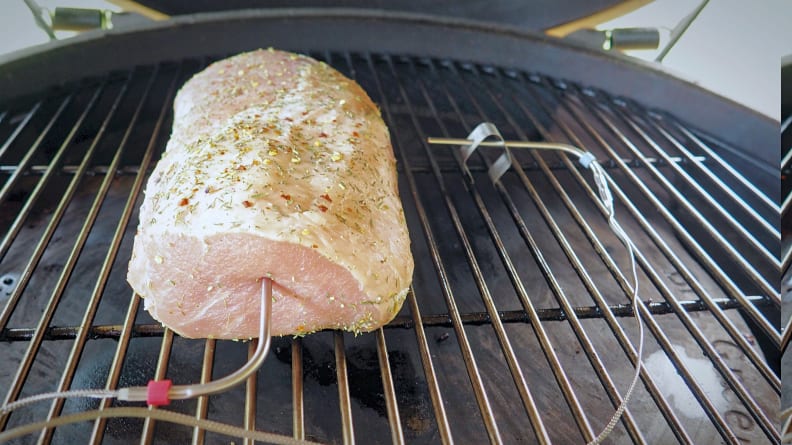
The included ambient probe monitors the grill's temperature while the longer probe measures the roast's internal temperature.
We tested the Weber Connect side-by-side with the Thermoworks Smoke X2, MEATER+, and a number of other models to find the best probe thermometer on the market. We tasked a professional chef (that’s me!) with grilling burgers over direct heat, cooking a pork loin over indirect heat, and smoking a pork shoulder. These tasks were performed at different grilling temperatures to assess the thermometer’s ability to measure ambient grill temperature and the meat’s internal temperature.
Our first task was to set up the probes, connecting them with their remote wireless receiver (or, in the case of the Weber Connect, syncing it with the smartphone app via bluetooth or WiFi). We used a iPhone XR on iOS 13.6.1 for the tests. Once the unit was properly set up, we fired up the grill and watched as the ambient probes measured the temperature inside the grill. When it came to the meat tests, we paid attention to how far we had to insert the probe, the size of the holes they left behind, and how easy it was to set target temperatures. Then, we walked as far away from the probe as possible, testing the strength of the connection to the smartphone app or wireless receiver.
We also wanted to test the thermometers’ accuracy, so we used them to measure the temperature of ice water (32° F) and boiling water (212° F at sea level, or 200.5° F at my elevation). These tests also allowed us to determine how quickly the thermometer could register temperature changes. We clocked the speed at which each probe measured the ice and boiling water, and averaged the results.
What we like about the Weber Connect

The app allows you to choose from a list of built-in programs for cooking several types of meat.
It's easy to connect and turn on and off
So the initial setup was a bit of a pain (more on that in a minute). But once the unit was set up, it was super easy to use. Simply plug a thermometer into the hub and the unit turns on. Turn it off by removing the thermometer. We were pleased to find that we could still use the app without turning on the hub, using it to browse through the cook programs, change from Fahrenheit to Celsius, and monitor the battery level.
Step-by-step cooking instructions are included
Advanced grillers might not need all the prep and cooking instructions included with the Weber Connect, but they’re extremely helpful for beginners. The cooking programs provide prep tips like preheating and cleaning the grill, whether to use direct or indirect heat, and video instruction for where to insert the probe. They’ll even show you how to trim and truss a boneless prime rib roast! Of course, if you don’t need this type of info, you can select a target temperature and skip all the extra instruction.
It remembers the settings
We were worried that closing out the app would cancel any existing cook programs, removing the alerts and causing us to overcook our roast. Instead, the alarm worked regardless of whether the app was open on our phone. In fact, it almost remembered the programs too well. After reaching the target temperature, you have to click “Done” or manually end the session in the app. Otherwise, it will still be set to the last program, even if it’s been a day or more since using the probe.
The battery is rechargeable
The Weber Connect hub comes with a USB charging cable and a rechargeable battery. You can check the status by the battery symbol’s color on the hub or via the settings page on the app. We used the hub to cook a pork loin and a pork shoulder without recharging it in between tasks, so it ran for about 15 hours. Weber promises a 20-hour battery life, but we didn’t want to push it much further and risk it turning off in the middle of a marathon grill session. The unit can be used while it’s charging, too, if you have an outlet near your grill.
WiFi and Bluetooth connectivity help monitor from afar
Bluetooth connections can only go so far, and if your grill is far from your house (like mine), it’s easy to drop the connection to your smart thermometer. The ability to hook up the Weber Connect to WiFi greatly extended the range. While the initial WiFi setup was a bit frustrating—you have to type in a case-sensitive network name and password, and it only worked when connecting to a 2GHz network—the Weber Connect remembered our device and WiFi network on subsequent cooks.
Probes are color-coded
It’s hard to keep track of multiple probes, especially if you’re using all four ports at once. We loved that each probe had a color-coded tag, both at the hub’s connection and on the probe itself, helping us identify the probes without having to follow all those wires.
You no longer need to guess the right grill temperature for chicken, beef, pork, and more
The USDA provides guidelines for safe meat temperatures, but you don’t have to look up grilling temperatures when using the Weber Connect. It has several built-in programs for cooking red meat, pork, lamb, poultry, and fish. The list of presets isn’t comprehensive (they’re missing chicken thighs, chicken drumsticks, and chicken wings, for example), but they do have a fair variety of options to choose from.
For our pork loin, we selected Pork Loin Roast, Boneless - 2-1/2 lbs - Medium from the list. We also had the option to choose Medium Well, but no Rare options (probably because the USDA defines safely cooked pork as a minimum of 145° F). The probe calculated the temperature and estimated cooking time. While the time estimates weren’t 100% accurate, they gave us a general idea of how long we had before the next step. They also got more accurate as the temperature got closer to the target. When we were alerted to take the loin off the grill, it registered 138° F (it reached the target 145° F while it rested).
If you don’t see your option on the list, you’ll need to look up the ideal meat temperature. Then, you can use the Target Core Temperature setting to enter the desired cooking temperature manually.
What we don’t like about the Weber Connect
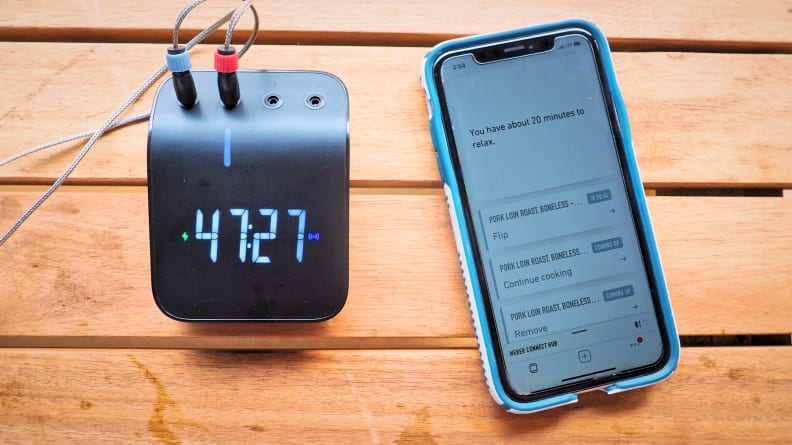
After selecting a program from the Weber Connect app, the hub displays a countdown to when you'll reach your target temperature.
The initial setup is tricky
You only have to go through this process once, but the initial setup was quite tedious. Don’t expect to take it out of the box and get cooking right away! The Weber Connect hub had to be connected to a power source, keeping your phone within a reasonable distance, for about 30 minutes while the unit updated the software and firmware. When the unit was fully updated, we had to re-pair it with our smartphone before it was ready to use. Since then, we’ve been able to connect automatically, so that’s a plus.
The hub’s display was finicky to use
The app is the real star of the Weber Connect, but the hub also displays the temperature of each probe. You can toggle between the displays by pressing on the hub, but the touch sensitivity was a bit off. Sometimes we had to press super hard while other times it moved between probes with little pressure. We also didn’t love that the display changed from temperature to a timed countdown when a probe was set to a cooking program. There was no way to switch it back to view the temperature.
The app lacks functionality
The app has a lot of potential, but it needs a little work. When used side-by-side with the MEATER+ app, we were especially disappointed. The Weber Connect app monitors the temperatures and provides step-by-step instructions, but it lacks any historical information. We wanted to see what we cooked in previous sessions, how long it took, and the peak vs. target temperature—as well as temperature graphs of the ambient and probe temperatures. This information might be overkill for some, but it’s useful for cooks looking to improve their grilling game.
It can’t be calibrated
Thermometer accuracy can drift, especially when it’s been exposed to high temperatures for long periods of time. Inaccurate thermometers aren’t very useful, especially when cooking things like poultry where temperature is crucial to food safety. Sadly, Weber probes can’t be calibrated, so you’ll have to buy a new one if the originals don’t record 32° F in ice water.
It only comes with two probes
We love that the hub is capable of tracking four different temperatures at once, but the unit only comes with two probes. They’re available for $15 each. Buying more won’t break the bank, but it would have been nice to get the extra probes included in the purchase price.
It's slow to read temperature changes
The Weber Connect isn’t rated for use with oil or other liquid applications, so we don’t recommend using it for deep-frying or other inside activities like making candy or cheese. That said, you wouldn’t want to: It was one of the slowest thermometers we tested. That’s not a problem for grilling meat, where you probe in the beginning and allow the thermometer to register the temps as the meat slowly cooks. But we wouldn’t want to use this as an instant-read meat thermometer.
Overall, how does the Weber Connect perform?
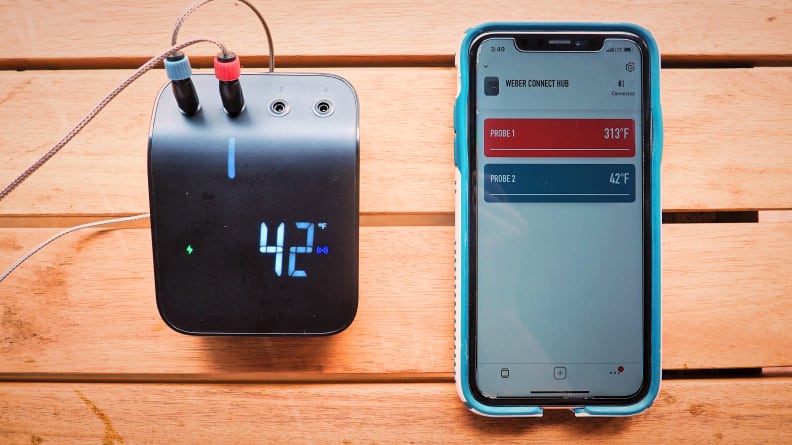
The temperature of each connected probe is visible on the hub or on the app.
All things considered, we were pretty pleased with the Weber Connect’s performance. It had some quirks, so we’re hoping Weber continues to make updates to their app. It looks promising in that regard; Weber has already announced that they’re planning a voice-assistant integration that would allow you to ask Alexa or Siri about the status of your grilling session. They also appear to be monitoring reviews closely and passing complaints and issues on to their app development team to increase future functionality.
The thermometer itself performed as well as many of the other models in our test group. It might bear the Weber name, but it’s compatible with any grill (we used it with the Big Green Egg). The base has four ports and the initial package comes with two probes. The ambient temperature probe is short with a rounded edge and a grill grate clip. Place it within a few inches of your meat, and it starts to measure the grill’s temperature. The remaining three ports can be used (all at once or only one at a time) to measure the meat’s internal temperature using a longer, pointed probe. You can view the temperature of these probes on the hub’s digital display or in the app.
The smartphone app is where all the magic really happens. Set custom temperature alerts or follow along with a variety of pre-loaded grilling programs. These programs allow you to choose the type of meat (including its thickness and whether it’s bone-in or boneless) and select the level of doneness. The program walks the griller through step-by-step instructions for prepping the grill, seasoning the meat, inserting the probe, and other tasks like when to flip your steak, move a roast to the indirect heat side, or reduce the grill’s temperature.
From there, you can walk away and receive alerts (both on the hub and as a notification sent to the smartphone app) when it’s time to perform the next action or the meat reaches its target temperature. The Bluetooth connection had a shorter range than the WiFi, but both automatically reconnected we re-entered the range’s radius. We found the Weber Connect to be just as accurate as the other probe thermometers we tested, and the instructions and extra information were a great way to inspire confidence in new grillers.
Where do I insert a probe thermometer?
The videos on Weber Connect’s cook programs take the guesswork out of where to insert a probe thermometer. They instruct you to insert the probe tip into the center of the thickest part of the meat, avoiding any bone or large pockets of fat. Each video shows where this spot is located on the chosen cut of meat.
Warranty
Most Weber accessories—including the Weber Connect—are backed by a two-year warranty. When it comes to the probes, cosmetic damage and damage due to exposure to direct flame or liquid are not covered. It’s best to clean the probes by wiping them down with a damp towel or sanitary wipe instead of exposing them to direct water. To avoid flame damage, suspend the wiring through the rotisserie slot or another opening in the smoker or grill. Never run the wiring through the smokestack, chimney, or exhaust vent, as these areas contain concentrated heat and can damage the probe cable.
Is the Weber Connect worth it?
After reading the reviews, I was a little worried about testing the Weber Connect. There were a lot of complaints about app functionality and bugs, but a lot of those issues must have been worked out. We didn’t experience any technical difficulties, and we were thrilled with the Connect’s performance. It offered a ton of functionality out of the box, and we love it as an option for new cooks. Even if it’s your first time cooking a pork shoulder or brisket, you should be able to pull it off using the video instructions and step-by-step alerts.
While $100 is a lot of money to spend on a thermometer, we think it’s worth it considering the hub has the ability to measure four separate probes. It works on any grill and with most smartphones, and it’s a fantastic way to help grillers to build confidence. There’s a lot to love about the current version, and we hope the app development team continues to expand the options. If they include temperature graphs, info about historical grilling sessions, and more built-in cooking programs (we’d love to see one for ribs, please!), this smart grilling hub would really knock it out of the park.

